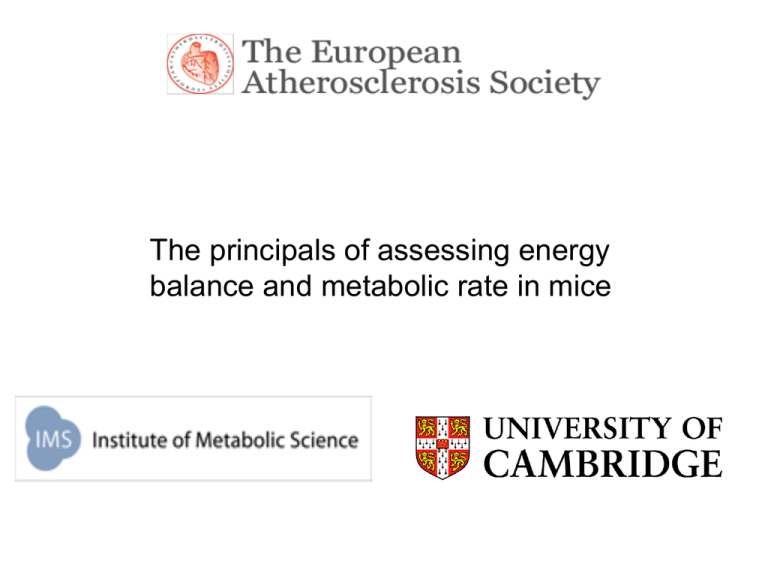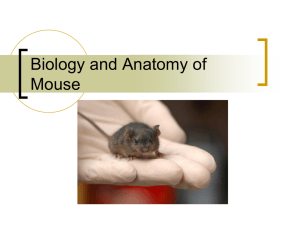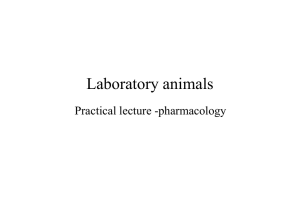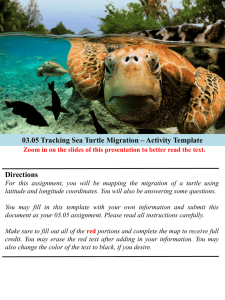The principals of assessing energy balance and metabolic rate in mice
advertisement

The principals of assessing energy balance and metabolic rate in mice Energy balance- the game has changed. Tschop et al Nature methods Dec 2012 What is energy balance? And what is metabolic rate? How do they differ? 1. ENERGY BALANCE Energy balance describes whether an organism will lose or gain weight. The size Of the organism is actually irrelevent for considering energy balance 30g 31g 30g of energy out 31g of food in 1 tonne and 1g Of food in 1 tonne + 1g 1 tonne of energy out 1. ENERGY BALANCE and rate of weight gain 31g of food in 1 tonne and 1g Of food in 30g of energy out 1 tonne of energy out 2 Metabolic rate With metabolic rate then the size of organism is very important, as we care about The rate of energy expenditure per g of the organism 30g 5g of energy out 5g of food in 30g 7g of food in 7g of energy out How do we measure food intake, energy balance and metabolic rate? To assess metabolic rate and energy balance we need 3 pieces of information 1. The body weight of the animal 2. The amount of food it has consumed* 3. How much energy it has expended *This correctly should be the amount it has assimilated. See point at the end. How to measure food intake and body weight How to measure energy expenditure Direct Methods: Calorimetry Indirect methods: Indirect calorimetry using gas exchange Doubly labelled water Direct Calorimetry Advantage – Most accurate method – does exactly what it says on the tin. Disadvantage – Sealed unit so (very) limited time scale for experiments. Indirect calorimetry 1 - Doubly labelled water Indirect calorimetry 2 – Gas exchange indirect calorimetry. What is an indirect calorimeter? Why does the volume of the chamber matter matter? 1.2 1 0.8 6.2l chamber 2.7l chamber 10l chamber 0.6 0.4 0.2 0 0 20 40 60 80 100 70 60 50 40 uncorrected for lag corrected for lag 30 20 10 0 0 10 20 30 40 50 60 What is Energy expenditure and how does it relate to VO2 and VCO2? EEJ = 15.818xV02 + 5.176*VCO2 Indirect calorimetery Oxygen consumption gives an indication of how much energy an animal is using as an animal will produce 4.8 KJ of energy per litre of oxygen with an error of around 6%. Carbon dioxide production is not a 1 to 1 ratio with oxygen consumption and the amount of CO2 produced varies dependent on the source of energy (Carbohydrate, Fat or Protein) Combining the amount of O2 consumed and the amount of CO2 produced gives us a value called the RQ which provides some information about fuel usage. RQ varies from 0.7-1 dependent on metabolic status of the animal What is Energy expenditure and how does it relate to VO2 and VCO2? EEJ = 15.818xV02 + 5.176*VCO2 Varies in ratio to oxygen by about 30% Therefore about 75% of the EE equation is driven by VO2 25% is driven by VCO2, which varies from equalling V02 to -30%. Therefore 25% of 30 ~6% - the error based on using 02 alone How about RQ A bit more on RQ RQ is VC02/VO2 Burning carbohydrate has an RQ of 1 because…. H O Therefore C O 1 molecule of C02 C O Requires 1 molecule H H O of O2 H n Burning fat has an RQ of 0.7 because…. H O C O C H n H H O Therefore 1 molecule of C02 Requires 1.5 molecules of O2 (1/1.5 =0.7) What does RQ mean? -Gives information about substrate utilisation -Mice fed a constant diet, so in mice probably gives more information about Energy balance -Can exceed 1 during periods of lipogenesis as lipogenesis has an RQ of about 5 Important points about body weight and experimental design Important point 1 EE J/min/mouse A larger mouse WILL expend more energy than a smaller mouse. 50 45 40 35 30 25 20 15 10 5 0 y = 0.8886x + 9.4426 2 R = 0.3757 P=0.0004 0 10 20 Bodyweight (g) 30 40 Important point 2 Food intake in (kj/mouse/8 days) A larger mouse WILL eat more energy than a smaller mouse. 700 600 500 400 y = 22.081x - 143.72 R2 = 0.8604 300 200 100 0 0 10 20 bodyweight (g) 30 40 Important point 3 Bodyweight When you study your mouse is very important. Time If a larger animal expends more energy, and my genotype of interest is obese and getting more obese relative to a control when I measure it, will it have higher EE? Probably yes Therefore what I need to know is if my animal has a DISPROPORTIONATELY Low EE for its body weight. How to normalise for body weight Traditionally people have used different comparators to straight body weight. A particularly common comparator is BW0.75 However this, along with BW0.72 and BW0.66 were developed for comparing across species, ie elephants and mice, rather than within species. Evidence suggests that these are not valid comparators for comparing within species, as we do. So then describing oxygen consumption as Ml/min/kg0.75 is not a good idea Is there a better method? ANCOVA How ANCOVA works Oxygen consumption A group with increased oxygen consumption per gram of animal Body weight Oxygen consumption A group with the same oxygen consumption per gram of animal Body weight When regression lines are not equal Oxygen consumption Idealised regression Body weight How about some real data? WT WT WT WT WT WT WT KO KO KO KO KO KO KO KO O2 ml/min/mouse 2.1425 2.3217 2.108415148 2.3652 2.240591387 2.2635 2.40299321 1.5767 2.0381 1.9817 2.110144446 2.031 1.979966916 2.318167748 2.220327835 Body weight g 34 32 31.1 29 34.3 35 37 29 33 29 33.3 33 37.7 37.6 35.4 Using traditional ml/min/kg0.75 NS Now to do some ANCOVAring When regression lines are not equal and cross in the area of interest Oxygen consumption Idealised regression Body weight So the model is valid! Oxygen consumption rates from 7 month old male mice fed a standard laboratory chow diet. Data collected from free living mice with ad libitum access to food over a period of 48 hours. N=8 per group. Chow diet. Oxygen consumption expressed as adjusted means based on a normalised mouse weight of 33.36g determined using ANCOVA. P<0.05 Other types of data from metabolic caging systems Other types of data Delta Body weight: weight out - weight in Important for understanding RQ and energy balance. Mice in negative energy balance will have lower RQ values (they are oxidising fat) and potentially disproportionately low EE (as they try to maintain fat reserves) Activity A very poorly understood variable and would take about another hour to discuss fully. I would recommend entirely ignoring this for the time being. Water intake May give very useful information regarding diabetic mice/kidney function. In general not a major variable in energy balance studies, however a dramatic loss in weight may be attributable to a failure to drink. Important to check this. Gut assimilation efficiency Not all food that is consumed will be absorbed into the body. Mice general operate in The mid-80% range for assimilation efficiency. Assimilation efficiency can be assessed using a bomb calorimeter to measure fecal energy content. Conclusions Energy balance describes the processes by which animals get fat. Metabolic rate describes the unitary mass energy expenditure. Assessing these variables accurately is essential for determining why your mouse is obese, lean or has altered metabolic function. Practical session 1. Testing that your data is valid 2. How to analyse your data. Testing that your data is valid Basic checks An important point about how a calorimeter measures CO2 and O2 CO2 = Air out – air in to give VCO2 O2 = Air in – Air out to give VO2 This is not a trivial difference!!! Lets imagine that we have a lot of water in our cage… The water dilutes the gases in the cage, reducing the CO2 and O2 measurements Coming out of the chamber 02in = 100% of normal CO2in = 100% of normal 02out = 90% of normal CO2out = 90% of normal These errors do not cancel because: CO2 = Air out – air in to give VCO2 O2 = Air in – Air out to give VO2 CO2 = 90 -100% of correct values so error is negative O2 = 100 – 90% of correct values so error is positive Therefore excessive moisture will drive down RQ as RQ = VCO2/VO2 Unusually low RQ values are indicative of an issue with moisture or drying… If all cages drift down, as well as the room air value, it may suggest the Air drying on your system is not working. If one animal has a drift in RER it may be a problem with a specific cage Exercise 1 – checking the data On your computer you will find the EXCEL sheet ‘training analysis’. Please open this file and proceed to tab ‘training data 1’ On this data set please graph (scatter plot) the O2% for room air Also place on a separate graph the RQ values for each mouse. You can compare this to training data 2, which does not have any problems Can we see any problems? Exercise 2 Look at training data 1 Please graph the EE column for each mouse Can we see a problem? What might have caused it? Summary of checks: Make sure zero gas = 0 Make sure span gas gives same reading as the bottle Make sure room air gives stable readings Make sure RQ average is sensible (average of 0.9 for high carb diet, nearer to 0.78 for HFD) Make sure there are no freak out lying values (may happen occasionally for CO2). Make sure data shows expected circadian rhythms (EE and RQ high at night, low in the day) Check all cages have roughly similar SD for RQ and EE. The minimum EE would normally be expected to be the first value (due to time constant of cage). How to analyse the data At this stage we will just take the average RER and average EE for the data set We have I have generated this data for you in the sheet called training analysis 1 Please calculate the average EE, body weight and perform a ttest between them Formula: =TTEST(G3:G9,G10:G16,2,2) So the animals have a lower average energy expenditure, while they do not have A significant difference in body weight there is a tendency for it to be lower. We now want to know if they also have a lower metabolic rate (EE per KG) To do so we need to normalise for body weight using ANCOVA. First we can get a feel for this by plotting BW on the x axis and EE on the y axis of A scatter plot. If the data fall on the same line, then the reduced EE is just caused by Reduced body weight. Try and make a plot with two data series placing BW on the x axis and EE on the y axis This is what you should get. As we can see the lines are parralel. We now need to see If they are statistically different… EE vs Average BW y = 0.5948x + 20.747 R2 = 0.6232 44 y = 0.4974x + 22.004 R2 = 0.5976 EE J/min/mouse 42 40 Series1 38 Series2 36 Linear (Series2) Linear (Series1) 34 32 30 25 27 29 31 Weight (g) ANCOVA. 33 35 37 How to actually RUN the ANCOVA SPSS data input screen – copy data into here Select variable tab to show this screen – type in names and change measure type. Select variable tab to show this screen – type in names and change measure type. Select ‘data’ menu and select define variable properties Select ‘genotype’ and press continue Type ‘WT’ and KO into the label section. Press ‘ok’ Select analysis menu > general linear model > univariate Make EE the dependent variable, genotype the fixed factor and body weight the covariate Select options and then ‘display means for:’ genotype. Tick compare main Effects box. Hit ok! The analysis will run. Test of between subject effects should be signficant for BW and genotype. Estimated marginal means show mean and standard error based on a 32.56g mouse Testing model validity… Go back to: analysis menu > general linear model > univariate Select model button. Select ‘custom’ model. Move genotype and BW indidually, then select both and Move them across to test for an interaction. Press continue and run the model. Ignore every thing but the genotype* BW value – this should be NON-significant If your model is valid… As you can see the lines do not cross in the region of interest… EE vs Average BW y = 0.5948x + 20.747 R2 = 0.6232 44 y = 0.4974x + 22.004 R2 = 0.5976 EE J/min/mouse 42 40 Series1 38 Series2 36 Linear (Series2) Linear (Series1) 34 32 30 25 27 29 31 Weight (g) 33 35 37 Exercise 3 Open the ‘formatted for SPSS tab’ Copy the data into SPSS and run the analysis. Refer to the hand out for instructions on how to do this… Compare the results of the ANCOVA analysis to the EE/BW and EE/BW^0.75 Data in the excel sheet ‘training analysis 1’ tab. What do you find? Bonus exercises If you have not already done so try plotting delta body weight against RER For the data on ‘training analysis 1’. What do you find and why? Secondly look at bonus training analysis. Check the average and the significance (t-test) of all the different values. Are any significant? If so what do you think this may tell us biologically? So overall… 1. Analysis of energy expenditure for Energy balance should not be normalised to body weight 2. Normalisation of energy expenditure or food intake should ideally be conducted Using ANCOVA. If this is not possible, then stick with per mouse. 3. Activity data can simply be expressed as counts per mouse. 4. Metabolic chambers will give you VAST quantities of data but much of it is meaningless unless you consider how you are analysing it carefully. Answer to bonus question 1 RER vs delta body weight 4 3.5 y = -39.852x + 38.606 R2 = 0.7325 3 weight loss 2.5 2 Series1 1.5 Linear (Series1) 1 0.5 0 0.88 -0.5 0.9 0.92 0.94 -1 RER 0.96 0.98 Answer to bonus question 2 Lipolysis at E max is impaired in basal and B3-adrenergic receptor stimulated states KO WT Answer to bonus question 2 Lipid Clearance TG 12 10 TG 8 WT 6 PPARy2 4 2 0 0 2 4 6 Time (Hours) 8 10 And in human obesity this is what we see…







